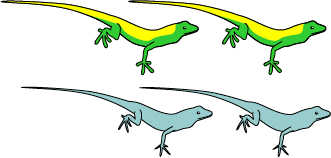Grade Level(s):
- 9-12
Source:
- Collins, Jennifer
Resource type:
- Lab activity
Time: Two class periods.
Overview
Students "take a trip" to the Greater Antilles to figure out how the Anolis lizards on the islands might have evolved.

- [History of life: Grades 9-12] Biological evolution accounts for diversity over long periods of time. (LS4.A, LS4.D)
- [Mechanisms of evolution: Grades 9-12] Traits that confer an advantage may persist in the population and are called adaptations. (LS4.B, LS4.C)
- [Mechanisms of evolution: Grades 9-12] Speciation is the splitting of one ancestral lineage into two or more descendant lineages.
- [Mechanisms of evolution: Grades 9-12] Speciation requires reproductive isolation.
- [Mechanisms of evolution: Grades 9-12] Occupying new environments can provide new selection pressures and new opportunities, leading to speciation. (LS4.C)
- [Nature of science: Grades 9-12] Scientific knowledge is open to question and revision as we come up with new ideas and discover new evidence. (P4, P6, NOS3)
- [Nature of science: Grades 9-12] Scientists test their ideas using multiple lines of evidence. (P6, NOS2)
- [Nature of science: Grades 9-12] Scientists use multiple research methods (experiments, observational research, comparative research, and modeling) to collect data. (P2, P3, P4, NOS1)
- [Nature of science: Grades 9-12] Scientists can test ideas about events and processes long past, very distant, and not directly observable.
- [Nature of science: Grades 9-12] Scientists may explore many different hypotheses to explain their observations. (P7)
- [Nature of science: Grades 9-12] Science is a human endeavor. (NOS7)
- [Studying evolution: Grades 9-12] Our knowledge of the evolution of living things is always being refined as we gather more evidence.
- [Studying evolution: Grades 9-12] Our understanding of life through time is based upon multiple lines of evidence.
- [Studying evolution: Grades 9-12] Scientists use the similarity of DNA nucleotide sequences to infer the relatedness of taxa. (LS4.A)
- [Studying evolution: Grades 9-12] Scientists use anatomical evidence to infer the relatedness of taxa. (LS4.A)
- [Studying evolution: Grades 9-12] Scientists use the geographic distribution of fossils and living things to learn about the history of life.
- [Studying evolution: Grades 9-12] Scientists use experimental evidence to study evolutionary processes.
- [Studying evolution: Grades 9-12] Classification is based on evolutionary relationships.
- [Studying evolution: Grades 9-12] Evolutionary trees (e.g., phylogenies or cladograms) are built from multiple lines of evidence.
- Disciplinary Core Idea LS4.A: Evidence of Common Ancestry and Diversity
- Disciplinary Core Idea LS4.B: Natural Selection
- Disciplinary Core Idea LS4.C: Adaptation
- Disciplinary Core Idea LS4.D: Biodiversity and Humans
- NOS Matrix understanding category 1. Scientific investigations use a variety of methods.
- NOS Matrix understanding category 2. Scientific knowledge is based on empirical evidence.
- NOS Matrix understanding category 7. Science is a human endeavor.
- Science and Engineering Practice 2. Developing and using models
- Science and Engineering Practice 4. Analyzing and interpreting data
- Science and Engineering Practice 6. Constructing explanations and designing solutions
- Science and Engineering Practice 7. Engaging in argument from evidence
Before beginning this lesson, students should understand that phylogenetic trees (cladograms) are hypotheses of how a set of organisms are related.
